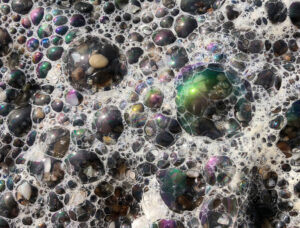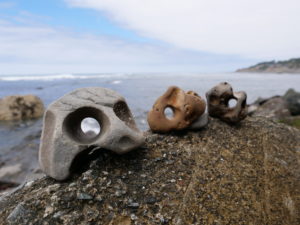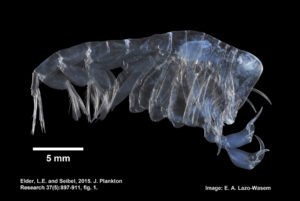You always know essentially where to find it: just aim yourself toward the western horizon, and go. At the road’s end, the trail’s end, the far end of that last dune-trudge or bluff-scramble, it’s there: a great conjunction of land, sky, and sea. North America meets Pacific Ocean.
Yet as surely as you may know the way there, you can never know what awaits you: What phenomena will flood your senses and deepen your sense of place in this living world. Will there be gigantic sea waves, born in a deep vortex a thousand miles away, exploding into frothing geysers on the sea stacks at McClures? Will a lone harbor seal commuting near the Limantour shore catch a rising wave from within and show itself, backlit, surfing–no, flying!–inside the water? Will an osprey plunge wishbone-deep into the sea near Sculptured Beach and then muscle back into flight, shuddering off spray, its talons locked on a 10-inch surf perch?
Immerse. Drakes Beach, late summer, nightfall; a soft overcast promises to drop down as wet fog. Friends hover near the embers of a driftwood fire. Gradually, another fire begins to manifest–in the breaking waves. Dim at first, and mildly greenish. Sky darkness deepens, and the oncoming surf is surely glowing brighter. At our feet, jets of brilliance zoom left or right: water-energy meeting the shoreline’s perfect curve. We stomp and shuffle in the wet-sand starburst. This is bioluminescence, visible light emitted by hordes of minute ocean creatures (such as the dinoflagellate Noctiluca) when excited by the likes of wave action. We, too, are decidedly excited and plunge into the water and the swirling clouds of microscopic life that luminesce our bodies.
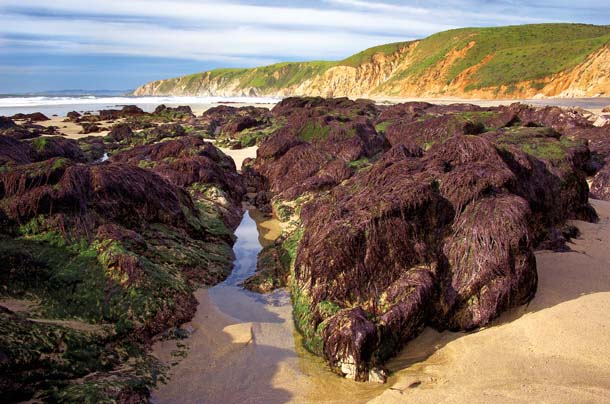
Point Reyes’ outer coast is all about expecting the unexpected. Even a favorite destination on the margin of this wild peninsula is never the same twice. Here, familiar is wedded to unprecedented, impermanent, primal.
Elemental forces hold sway. Weather pulses onshore as part of a flow that fills the whole North Pacific basin. Storm-powered surf drags six or more vertical feet of sand off beaches in winter. Just offshore the California Current churns north-to-south, chilling and mixing local ocean water, producing exceptional concentrations of marine life. Onshore habitats, too, are richer for this region of upwelling, one of a handful in the world ocean. Life zones that intersect here host a multitude of creatures: single-celled to great-whale-sized; drifting or locomoting; migrating or colonizing or simply coping with an accidental arrival on currents of wind and water. Tides raise and lower the ocean by as much as nine feet in a span of six hours; a minus tide will pull the curtain open, for just a while, on one of the greatest biodiversity shows on earth.

Investigate. McClures Beach, late spring, sunrise. Extreme low-tide pilgrimage down to sea level (still receding). Boulders heaped with gleaming kelp display the year’s phenomenal crop of macroalgae (still growing). Beyond a stony passageway lies a wet and slippery cove where the mad-laughter calls of black oystercatchers echo off the cliffs. Life coats every surface and has found a phenomenal range of ways to express the theme of “clinging-to-rock-in-frothing-surf.” Seawater is essentially soup, rich in ground-up, once-living matter–detritus. If you can suck and filter sea water, or prey on something that does, or scavenge upon its remains–and resist desiccation when exposed, and tolerate wave shock–success! Competition for space is intense, and the place is a jumble of resilient anemones, crusting sponges, tough sea stars, scampering arthropods, muscled gastropods, glued-down barnacles, tied-down bivalves, and holding-fast algae. Amidst this riot of colorful lifestyles, a curiously drab blob hangs from a boulder’s underside. Though it scarcely passes for a living thing, let alone an animal, this sack-like creature is our closest relative among the invertebrates, a tunicate. It has a flexible cord of stranded nerves, precursor to a human’s spine (a fact that lends the tunicate, improbably, charisma).
Rocks, reefs, bluffs, dunes, surf. How to embrace this grand coastal zone? Point Reyes’ outer edge seems surreally long relative to the size of the land it rims. The peninsula measures 28 miles from stem to stern and, at its widest–between the lighthouse and the San Andreas Fault zone–about 12 miles. Its total area is just over 110 square miles, yet it touches oceanic waters along a span of fully 63 miles, about half-and-half rocky shore and sandy beach.
A saltwater margin wraps the body of the land like a living skin. Rocky bluffs, muscular, confront the ocean head-on. Between headlands there are softer recumbent landforms, hollowed by water and shaped at their edges into sand beaches. Layers of Point Reyes geology, tilted and torqued, meet the sea in a mosaic of pocket beaches, sculpted sea stacks, an improbable waterfall, and broad shale reefs.
Trace the coastline here; sample its power and diversity.
Remote in the northwest, Tomales Point thrusts a granitic finger in the direction of transit for this floating island . . . toward the Aleutian Trench. Just to the south, headlands are edged with a jumble of rock ocean-battered over eons. The largest lump, guano-covered Bird Rock, holds the same critical value as many an ocean isle: isolation from terrestrial predators. Nesting seabirds and resting pinnipeds love this, need it, and likewise inaccessible crannies all along this broken shore.
Journey on to the Great Beach, 11 miles of unbroken, dune-backed, high-energy surf–an expansive spectacle of driftwood, steep sand, and crashing waves that may stir reflections upon California before so many shores were leveled, groined, built upon, raked bare of any wild debris. Playground or habitat: can beaches be both?
Imagine. Abbotts Lagoon, summer solstice, midmorning. The north wind is already kicking up a white haze on the horizon. Gulls loiter near the tide line, brown pelicans oscillate along the fronts of cresting waves, and the beach appears empty. Unseen, a true denizen of this landscape hunkers in a divot, protected from predators only by its appearance and behavior. The snowy plover is a tiny shorebird whose camouflage and cryptic markings enable it to vanish against sand and scattered drift. You could walk within inches and miss this creature . . . except that this male has two chicks nearby (the third likely taken by a raven). Should a dog approach the chicks–mottled fluff on long legs, now crouching perfectly still at their parent’s signal–the adult will throw himself into a distraction display worthy of an Oscar. Wings flailing as if crippled, crying as it goes, the plover lures its enemy away, then vanishes again within its terrain. While such fine adaptations have not immunized snowy plovers on the West Coast from a century of insults to their habitat, they still cling to home in the sands of Point Reyes Beach. This parent calls his chicks to his side, then leads them on a ploverly chase for kelp flies.
Kehoe, Abbotts, North Beach, South: this is genuinely wild sandy shore, pummeled by northwesterly winds and big wave trains. Winter swells may rear up a quarter-mile offshore and collapse in thunderous, foaming waterfalls.
On to the lighthouse and Chimney Rock headlands. The blunt fist of outer Point Reyes juts so far into the ocean that it actually mixes things up in the California Current. A plume of localized upwelling enriches sea life in the Gulf of the Farallones, and mobile vertebrates from herring to humpbacks congregate here for the feast that ensues.
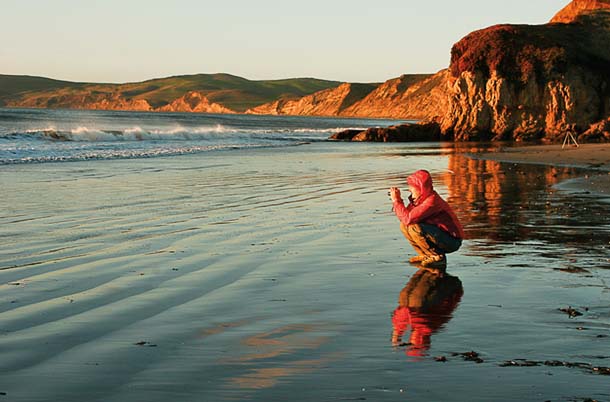
Just inside the peninsula’s bent wrist, where Drakes Bay begins, northern elephant seals are multiplying. Driven close to extinction 100 years ago, this giant pinniped has made a dramatic return; several hundred now haul out at Point Reyes each winter to squabble, bond, and breed. The Drakes Bay colony alone produced 330 weaned pups in 2012. Wildlife populations, like everything oceanic, are in flux.
Also in the lee of Point Reyes, sand grains too fine to settle out on the Great Beach swash into Drakes Bay on a curving back-eddy. The same curve, writ large, has sculpted cliff walls of blond shale. These are layered remains of minute marine organisms that rained upon ancient seafloors. Protected bay waters are haven for grebes and scoters and loons. Willets and marbled godwits may probe wet sand to extract living nuggets of food, while troops of silvery sanderling motor back and forth in shallow waves on a blur of running legs.
Limantour Spit. Coast Camp. Sculptured Beach. Coast Trail. Arch Rock. Wildcat. Alamere Falls. Palomarin Reef. And beyond–Bolinas Point, Duxbury Reef, the mouth of Bolinas Lagoon. A shoreline to occupy a lifetime.
Just stand still then, at the tip of Chimney Rock, for example, and consider: This exquisite coast has always, and never, been just like now.
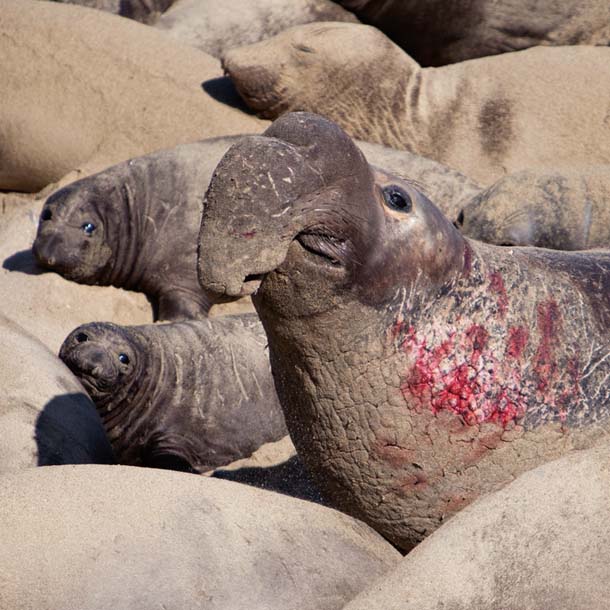
“Crowning Glories” was produced in collaboration with: Point Reyes National Seashore Association (PRNSA) is the primary nonprofit partner of the National Park Service at Point Reyes. PRNSA mobilizes community support for resource preservation projects within the park and provides environmental education programs that help people explore, discover, and connect with the natural world (ptreyes.org). National Park Service/Point Reyes National Seashore manages and provides public access to 90,000 acres of national park lands on and around the Point Reyes peninsula (nps.gov/pore). Funding for “Crowning Glories” was provided by the Point Reyes National Seashore Association and the JiJi Foundation, which supports conservation, research, and science education on environmental issues in California and Baja California.


